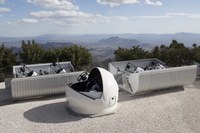MINERVA Telescope Array Dedicated in Ceremony on Mount Hopkins
The MINERVA telescope array in Arizona was dedicated in an official ceremony at the facility on Mount Hopkins on May 18, 2015.
MINERVA stands for Miniature Exoplanet Radial Velocity Array, a group of small-aperture robotic telescopes that search for Earth-like exoplanets near our solar system, within about 75 light-years from our Sun.
“We’re very proud of how quickly and seamlessly the MINERVA array has come together. Now we at Penn State can use the array to find new planets and to give our students practical experience with remote observation,” said Assistant Professor of Astronomy and Astrophysics Jason Wright, who leads Penn State’s involvement in the project. “MINERVA will be an important part of the research portfolio of the Center for Exoplanets and Habitable Worlds here at Penn State.”
Penn State partners with three other universities on MINERVA, with each university contributing one of the array’s four telescopes: Harvard University, the University of Montana, and the University of New South Wales. A fifth institution, the University of Pennsylvania, operates a sister project, MINERVA-Red, at the same site.
The MINERVA telescope array is housed at Fred Lawrence Whipple Observatory, a field installation of the Smithsonian Astrophysical Observatory, located in Mount Hopkins, Arizona. The dedication ceremony took place at the observatory and was attended by MINERVA team members, dignitaries from the partner institutions, and Whipple Observatory staff at Mount Hopkins. The dedication ceremony included a dinner, short presentations by the principal investigators, and a rare chance for stargazing through the telescopes in the early evening.
“MINERVA offers a powerful new approach to planet hunting. Wright and his collaborators have designed an innovative observatory that combines four high-end consumer-grade telescopes with a single custom-built high-precision spectrograph. The result is a powerful planet-hunting machine that will be competitive with significantly larger and more expensive observatories,” said Eric Ford,professor of astronomy and astrophysics at Penn State. “Sometimes each telescope will focus on a different target, allowing Penn State students to nimbly respond to transient phenomena. Other times, all four telescopes will work together to measure the acceleration of a single star caused by an orbiting planet.”
Using high-end consumer-grade telescopes made the new facility a relatively inexpensive investment in searching for exoplanets. Even with the custom spectrograph, the MINERVA array cost around $3.5 million, as opposed to a more typical price tag of $10 million for a new professional telescope.
While the astronomers from these four institutions regularly collaborate on MINERVA research, that process usually takes place via online communication. The dedication ceremony was a rare opportunity for the principal investigators from all four universities to meet in person.
“Conference calls work very well, but there’s always value in talking face-to-face and meeting students from the other institutions in person,” said Wright. “Spending an afternoon and dinner together helps you get to know the team in a way you can’t when following an agenda over a speakerphone.”
Wright will use the MINERVA telescope array to conduct exoplanet research alongside his fellow MINERVA investigators John Johnson (Harvard University, principal investigator on the project), Nate McCrady (University of Montana), Rob Wittenmyer (University of New South Wales), and Cullen Blake (University of Pennsylvania).
“Construction of the MINERVA array is a very timely response to the growing need for devising new, efficient ways to discover extrasolar planets,” said Evan Pugh Professor of Astronomy and Astrophysics Alex Wolszczan, who first discovered planets outside our solar system in 1992. “I do not think I risk much by saying that its success is guaranteed!”
Source: http://science.psu.edu/news-and-events/minerva-telescope-array-dedicated-in-ceremony-on-mount-hopkins






